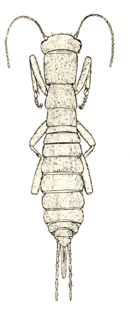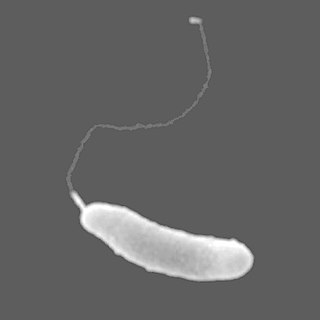 W
WArthrobacter is a genus of bacteria that is commonly found in soil. All species in this genus are Gram-positive obligate aerobes that are rods during exponential growth and cocci in their stationary phase. Arthrobacter have a distinctive method of cell division called "snapping division" or reversion in which the outer bacterial cell wall ruptures at a joint.
 W
WGrylloblatta campodeiformis, also known as the Northern Rock Crawler, is an omnivorous species of insect in family Grylloblattidae. Like other species in the genus Grylloblatta, it is endemic to North America.
 W
WGrylloblattidae, the icebugs, or ice crawlers, is a family of extremophile (psychrophile) and wingless insects that live in the cold on top of mountains and the edges of glaciers. They belong, along with Mantophasmatidae, to the order Notoptera. Grylloblattids are tiny, most being less than 3 cm long, wingless insects with a head resembling that of a cockroach, with long antennae and having elongated cerci arising from the tip of their abdomen. They cannot tolerate warmth and many species have small distribution ranges.
 W
WMarinomonas arctica is a Gram-negative, psychrotolerant and motile bacterium from the genus of Marinomonas which has been isolated from sea-ice from the Canadian Basin from the Arctic Ocean.
 W
WPseudomonas is a genus of Gram-negative, Gammaproteobacteria, belonging to the family Pseudomonadaceae and containing 191 validly described species. The members of the genus demonstrate a great deal of metabolic diversity and consequently are able to colonize a wide range of niches. Their ease of culture in vitro and availability of an increasing number of Pseudomonas strain genome sequences has made the genus an excellent focus for scientific research; the best studied species include P. aeruginosa in its role as an opportunistic human pathogen, the plant pathogen P. syringae, the soil bacterium P. putida, and the plant growth-promoting P. fluorescens, P. lini, P. migulae, and P. graminis.
 W
WPseudomonas teessidea is a species of Pseudomonas bacteria which was first discovered in the North of England. The specific epithet teessidea was given by a microbiologist at Teesside University. This bacterium has unique properties developed in response to the contaminated soil from which it comes. It produces rhamnolipids, which are biosurfactants which detoxify oil and chemicals contaminants in the ground. Surfactants work by reducing surface tension between two liquids or a liquid and a solid.
 W
WSphingomonas was defined in 1990 as a group of Gram-negative, rod-shaped, chemoheterotrophic, strictly aerobic bacteria. They possess ubiquinone 10 as their major respiratory quinone, contain glycosphingolipids (GSLs), specifically ceramide, instead of lipopolysaccharide (LPS) in their cell envelopes, and typically produce yellow-pigmented colonies.
 W
WTardigrades, known colloquially as water bears or moss piglets, are a phylum of eight-legged segmented micro-animals. They were first described by the German zoologist Johann August Ephraim Goeze in 1773, who called them little water bears. In 1777, the Italian biologist Lazzaro Spallanzani named them Tardigrada, which means "slow steppers".